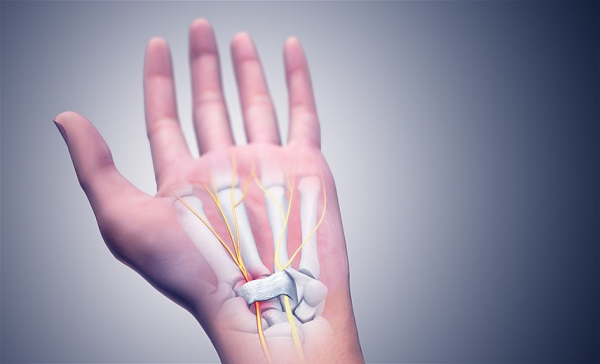
Tips to overcome Carpal Tunnel Syndrome
Are you a person who works on computer all the day? Do you have pain in your wrists? This could be carpal tunnel syndrome.
What is Carpal tunnel syndrome?
Carpal tunnel is made of the bones in the wrist and the ligaments, which runs across the base of the palm. The median nerve is squeezed where it passes through the wrist in this condition. This often happens because the tendons in the wrist have become swollen and they press on the nerve. The median nerve controls some of the muscles that move the thumb and it carries information back to the brain about sensations in your thumb and fingers.
What causes carpal tunnel syndrome?
Most people develop this syndrome at work place. It is often caused by work-related activities, such as typing, and repetitive movements of wrists. Some cases may be related to arthritis of the wrist, thyroid disease and pregnancy. Pushing up by pressing your hands, lifting heavy weights can also cause this. Your risk of developing it may be greater if your job places heavy demands on your wrist or if you use vibrating tools.
How to overcome carpal tunnel syndrome?
Giving rest for the activities that trouble the wrist is one of the best options. Other remedies are:
Wearing splints: Wearing a resting splint can help prevent the symptoms occurring at night, or a working splint can be useful if your symptoms are brought on by particular activities like yoga, Pilates, weight lifting.
Steroid injections: To reduce inflammation, your doctor or physiotherapist can give you a steroid injection into your carpal tunnel. The injection may be uncomfortable, but the effects can last for weeks or months.
Simple exercises: Wrist exercises can help to reduce the pain and people overcome this syndrome. Exercise is better than taking steroid injection.
Wrist bend (forward and back): Rest your elbow on a table, arm pointing up, wrist straight. Gently bend your wrist forward at a right angle and hold for 5 seconds. Straighten your wrist. Gently bend it backwards and hold for 5 seconds. Do 3 sets of 10 repetitions.
Wrist lift: Place your palm on the table and lift the fingers up. Place your other hand across the knuckles at 90º and push down as the bottom hand tries to pull up. You should feel the muscles of your forearms contracting. Swap hands and repeat.
Wrist flex: Keeping your arm straight in front with your palm facing down, gently bend your wrist down. Use the opposite hand to press the stretching hand back towards your body and hold for 15–30 seconds. Straighten your wrist. Gently bend the stretching hand backwards and use the opposite hand to pull the fingers back. Hold for 15–30 seconds. Do 3 3 sets with each wrist.
Finger bend: Start with your fingers held out straight. Gently bend the middle joints of your fingers down toward your upper palm and hold for 5 seconds. Do 3 sets of 10 repetitions. Wrist stretch with weight Holding a light weight (e.g a tin of beans), stretch your arm out in front with your palm down. Slowly bend your wrist upward, and then return to the starting position. Do 3 sets of 10 repetitions. Gradually increase the weight you hold.
Hand squeeze: Squeeze a rubber ball and hold for 5 seconds. Do 3 sets of 10 repetitions.
Mid-trap exercise: Lie on your stomach on a firm surface and place a folded pillow underneath your chest. Place your arms out straight to your sides with your elbows straight and thumbs toward the ceiling. Slowly raise your arms toward the ceiling as you squeeze your shoulder blades together. Lower slowly. Do 3 sets of 15. As the exercise gets easier to do, hold soup cans or small weights in your hands.
Pectoralis stretch: Stand in an open doorway or corner with both hands slightly above your head on the door frame or wall. Slowly lean forward until you feel a stretch in the front of your shoulders. Hold 15 to 30 seconds. Repeat 3 times.
Scalene stretch: Sit or stand and clasp both hands behind your back. Lower your left shoulder and tilt your head toward the right until you feel a stretch. Hold this position for 15 to 30 seconds and then come back to the starting position. Then lower your right shoulder and tilt your head toward the left. Hold for 15 to 30 seconds. Repeat 3 times on each side.
Thoracic extension: Sit in a chair and clasp both arms behind your head. Gently arch backward and look up toward the ceiling. Repeat 10 times. Do this several times each day.
Scapular squeeze: While sitting or standing with your arms by your sides, squeeze your shoulder blades together and hold for 5 seconds. Do 2 sets of 15.
Carpal tunnel syndrome treatment is usually easy to access. Symptoms tend to be worse at night – hang your hand out of bed or shake it around to ease pain.
Carpal tunnel syndrome can usually be easily treated. Symptoms tend to be worse at night – hang your hand out of bed or shake it around to ease pain. Certain activities can bring on symptoms. Wearing a working wrist splint may be helpful. Try the exercises and contact your doctor for proper guidance and medicines.
References:
- http://www.summitmedicalgroup.com/
- http://www.steadyhealth.com/
- https://onlinecarpaltunnel
Image credit: https://commons.wikimedia.org/wiki/File:Carpal_Tunnel_Syndrome.jpg
Attribution: www.scientificanimations.com / CC BY-SA (https://creativecommons.org/licenses/by-sa/4.0)
Author: HealthyLife | Posted on: November 3, 2016
« Where and how foods are stored in refrigerators? Many tips to take care your lips »






















Write a comment